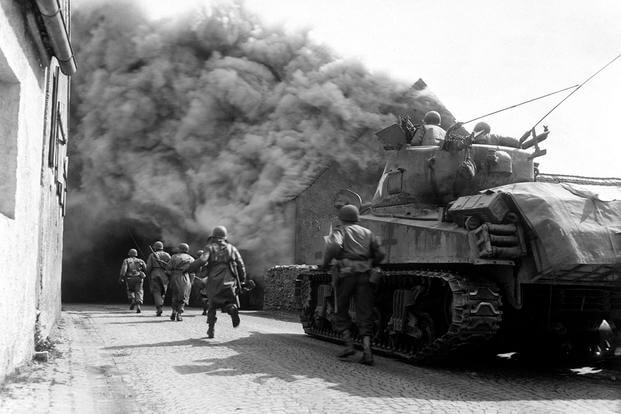Soldier Arrived in Europe Ready for Battle and Became Part of an Occupation.
Born in Bloomington, Ill., in 1924, Edward Ambrose White was the son of a civil servant and had one sister. He grew up mostly in Peoria.
After graduating from high school in 1942, White enrolled at the University of Illinois. Now 76, he recalled recently his attempts to join the war effort through the Navy's V-12 college training program
"I applied … but was turned down during the physical because I had albumin in my urine," recalled White. "I asked my uncle who was a medical doctor what to do. He told me to eat lots of eggs."
White was in the Coast Artillery ROTC at the University of Illinois and ended up enlisting in the Army. He was promptly sent to Camp Wallace, Texas, for training in air defense artillery. Camp Wallace was located halfway between Galveston and Houston and treated White to the hottest summer of his life, along with his basic training.
After basic training, White scored so well on the armed forces aptitude test that he had his choice of pilot training or engineering under the Army Specialized Training Program (ASTP). He chose engineering and was sent to The Citadel in Charleston, S.C., where he spent September 1943 to March 1944. In the spring of 1944, the Army abandoned the ASTP and White was back in the manpower pool once again.
He was assigned to the 100th Division and trained briefly at Fort Benning, Ga., and then went to Fort Sill, Okla., where he was assigned to a unit testing the then-secret proximity fuse on ammunition for the 155mm howitzer. He recalled a test in which they fired conventional ammunition at a hillside and then fired rounds with the proximity fuse.
"Nothing was supposed to be left alive after being in the vicinity of a round with the proximity fuse," he said, "but as soon as the round impacted, a deer ran out of the impact area without a scratch."
Then, it was off to Fort Riley, Kan., for more training and loading up the howitzers and equipment on rail cars. The soldiers were required not only to chain the artillery pieces to the cars, but also to attach 6-by-6-foot timbers to the ends of the rail cars to further insure that the equipment didn't roll off the train. This sounds fine, but White said the timbers were made of oak and the spikes they were given to pound through the timbers bent and would not penetrate the hard wood. They gave up. Soon thereafter, a sergeant came along and chewed them out for not attaching the timbers. White suggested that the sergeant try it himself. The sergeant did, and after obtaining similar results, told them they didn't need the timbers after all.
Victory in Europe
White's unit was shipped out to Europe on a troop ship in April 1945. White learned of President Franklin Roosevelt's death during that voyage.
Once they made landfall at Le Havre, France, they headed across the Saar to Bitburg, Germany. On May 8, 1945, the war in Europe ended, and White and his unit became part of the occupation forces.
White remembers vividly some graffiti he saw scrawled on the side of a building in Germany. The German words said, in effect, "Give me five years and you won't recognize Germany. Adolf Hitler." Whether or not the slogan can be properly attributed to Hitler is a matter of debate, but it made a big impression on the American troops who saw it.
During the early part of the occupation, a German farmer told them there were 28 bodies of American soldiers nearby. White was part of the group who recovered the remains, took one dog tag from each and contacted a Graves Registration team.
As a corporal, White was a company clerk, a job he found too confining. He worked his way into a position as a battery noncommissioned officer. The company clerk job tied him down to one place, whereas the portable duties of the battery NCO gave him the latitude he sought. He could be where he wanted to be and when he wanted to be there.
In early July 1945, White sailed back to the United States for 30 days furlough before reporting to San Francisco for duty in the Pacific. Fortunately, the war ended in the Pacific while he was on furlough. He was discharged in February 1946 at Fort Chafee, Arkansas.
After the service, White married, had three children and worked as a chemical engineer until his retirement.















